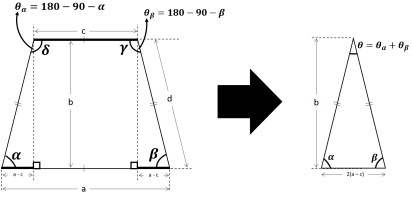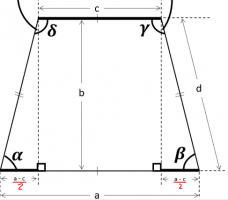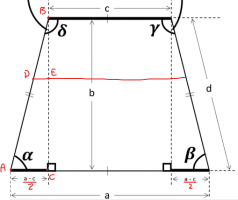Leaderofrouge
New member
- Joined
- Jul 15, 2022
- Messages
- 2
Hi all,
My question is: Should a mathematical statement that describes a right angle trapezoid be generalisable to other trapezoid.
Below is the context.
I am trying to derive a generalised equation to calculate for an intermediate length of a badminton shuttlecock which takes the form of a trapezoid as shown below:
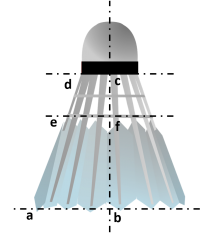
The length in question is ef.
I wasn't too sure on how to get started initially and went on to do a quick search over the Internet where I found some suggestions about using the law of sines which initially seemed to be working out (see below):
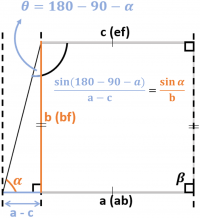
(Since my question about the understanding and not the calculation itself, I won't be including the step-by-step working unless someone wants to see it for a particular reason.)
Using the above equation, I was indeed able to rearrange and solve for c; so, everything seems logical in my mind at the time and did not think too much about it.
Then, a couple of days ago I came back to the equation and tried to write a generalised statement but got stumped, as it does not seem to work:
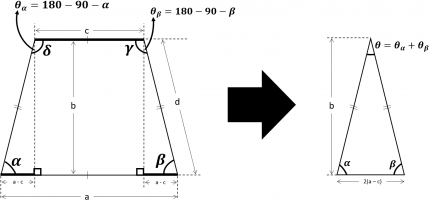
As can be seen, an extra "a-c" has appeared. I understand that I have only been working with half the trapezoid to begin with, but I did not think the general equation should change --- i.e., I would the ratio of the two "a-c" to be doubled/halved depending on the perspective but that is not what I am doing here (at least I don't think I am).
So, I am wondering if a right angle trapezoid is some sort of special case and cannot be generalised?
Thanks in advance and much would appreciated if someone could point out where my misunderstanding is occurring from.
Cheers!
P.S. I would also be interested if anyone else has another suggestion on how to approach the problem.
My question is: Should a mathematical statement that describes a right angle trapezoid be generalisable to other trapezoid.
Below is the context.
I am trying to derive a generalised equation to calculate for an intermediate length of a badminton shuttlecock which takes the form of a trapezoid as shown below:

The length in question is ef.
I wasn't too sure on how to get started initially and went on to do a quick search over the Internet where I found some suggestions about using the law of sines which initially seemed to be working out (see below):

(Since my question about the understanding and not the calculation itself, I won't be including the step-by-step working unless someone wants to see it for a particular reason.)
Using the above equation, I was indeed able to rearrange and solve for c; so, everything seems logical in my mind at the time and did not think too much about it.
Then, a couple of days ago I came back to the equation and tried to write a generalised statement but got stumped, as it does not seem to work:

As can be seen, an extra "a-c" has appeared. I understand that I have only been working with half the trapezoid to begin with, but I did not think the general equation should change --- i.e., I would the ratio of the two "a-c" to be doubled/halved depending on the perspective but that is not what I am doing here (at least I don't think I am).
So, I am wondering if a right angle trapezoid is some sort of special case and cannot be generalised?
Thanks in advance and much would appreciated if someone could point out where my misunderstanding is occurring from.
Cheers!
P.S. I would also be interested if anyone else has another suggestion on how to approach the problem.

